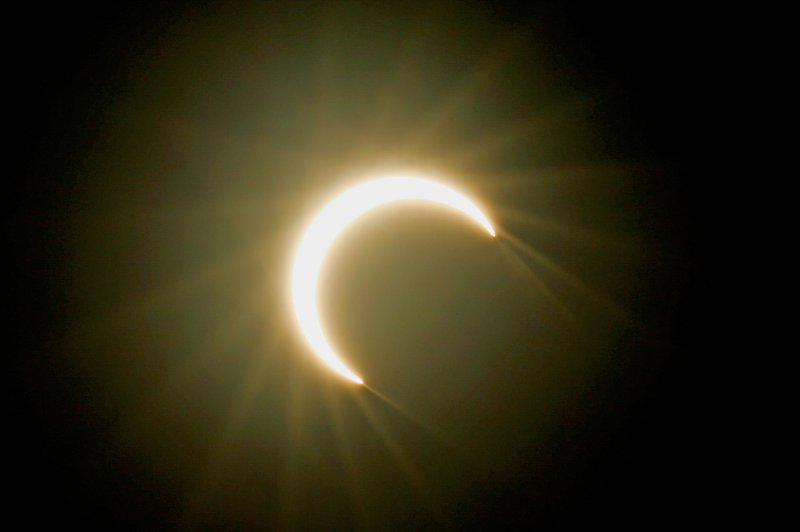Researchers say that a total solar eclipse expected in April 2024 could be the last one visible from the contiguous United States until 2045. File Photo by Ali Haider/EPA-EFE
What will the weather be like on April 8, 2024? That will be the question on the minds of millions of people over the next two years leading up to a spectacular total solar eclipse.
April 8, 2024, will be the only chance to see a total solar eclipse from the contiguous United States until 2045, making it one of the must-see astronomy events of the decade.
"The opportunity to see an eclipse without traveling internationally should not be missed," expert eclipse photographer Gordon Telepun told AccuWeather. "It's two years before the eclipse, but it is not too early to begin making plans."
The 2024 eclipse is an encore of the Great American Eclipse that captivated millions of people from Oregon to South Carolina on Aug. 21, 2017. According to experts, the 2024 eclipse will be even more impressive than the last.
To witness a total solar eclipse, onlookers need to be in the right place at a precise time. This area is known as the path of totality. Being in the path and being outside of the path on April 8, 2024, will literally be the difference between night and day.
"The path of the 2024 eclipse across North America is exciting," Telepun said. "It crosses more large cities than the 2017 path."
Over 31 million people live in the path of totality for the 2024 eclipse, which is more than double the 12.25 million people that were in the path of the 2017 eclipse, according to astronomy.com.
Dallas and Austin, Texas Little Rock, Arkansas Indianapolis, Indiana Cleveland and Dayton, Ohio Buffalo, New York Burlington, Vermont and Montreal, Quebec all are situated in the path of totality.
Additionally, many large cities are just a short drive away from the path, such as San Antonio, Texas, St. Louis, Chicago, Cincinnati, Detroit and Pittsburgh.
What has scientists intrigued about the 2024 event is not the cities in the path, but the length of totality.
Totality will last over four minutes for part of the path across the U.S., nearly double the length of the 2017 eclipse that lasted just over two minutes for many viewing areas.
It is still too early to make a precise weather forecast, but the time of year that the 2024 eclipse takes place could be problematic for some onlookers.
"The weather in April could present challenges along the entire path," Telepun said.
Based on the average cloud cover across the country in early April, the southern U.S. has the best chance of having cloud-free weather on April 8. The odds of it being cloudy on this day increase farther north and east based on climatology.
However, the actual weather on eclipse day could be much different than climatology. "Watching the weather fronts a few days before the eclipse will be essential to success," Telepun said.
This means that folks that live in the path of totality from Ohio to Maine may still want to consider traveling due to the risk of cloudy conditions.
"If you manage to position yourself in clear skies on eclipse day, you have a chance to observe and image the corona," Telespun said. "It's spectacular, no doubt about it!"
One of the most important parts of viewing a solar eclipse is having the proper eye protection. Looking at the sun without a special solar filter or "eclipse glasses" can lead to serious eye damage.
In 2017, many online vendors sold out of eclipse glasses in the months leading up to the eclipse, making the glasses hard to find leading up to the main event.
Purchasing eclipse glasses now and keeping them in a safe spot ensures that you'll be able to enjoy the celestial show once April 8, 2024, rolls around.
The American Astronomical Society has a list of reputable vendors that comply with the solar filter standard, known as ISO 12312-2. If a solar filter does not have this number printed on them, then it may not be safe to use.
Telepun also recommends buying a good quality thermometer to record the drop in temperature as the moon blocks out the sun.
"Most total solar eclipses can cause a 10 to 15°F drop in temperature," he said. "In the right conditions, it can be more."
Telepun was in Bella Vista, Argentina, for a total solar eclipse on July 2, 2019, and during the eclipse, the mercury fell from 67.1 F to 41.9 F, a drop of 25.2 degrees.
![]() |
| The temperature in Bella Vista, Argentina, fell by more than 25 degrees F during a total solar eclipse on July 2, 2019. The total phase of the eclipse occurred during the times above labeled C2 and C3. |
It also can't hurt to practice making eclipse crafts such as pinhole projectors to use during the partial phase of the eclipse.
During the partial phase of the eclipse, which lasts for just under two hours before and after totality, a pinhole poked in paper can reveal the crescent shadow of the moon blocking out part of the sun.
Common household items such as colanders can also be used as a makeshift pinhole projector.
![]() |
| Crescent-shaped light shines through the holes in a colander during the partial phase of a solar eclipse. |


















